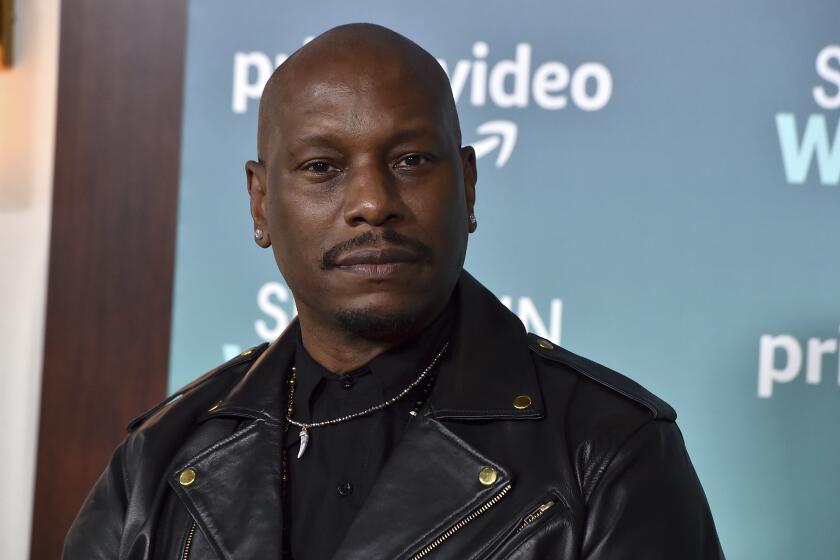Fabulous Film Costumes of Past to Glitter Again
They just don’t make movies like they used to. Nor can today’s Hollywood match the aura created for such screen goddesses as Greta Garbo, Carole Lombard and Jean Harlow in the glamorous gowns they wore.
“Nowadays when they create costumes for a movie, they go to Nordstrom and buy jeans,” said fashion historian Kathryn Harris. “We don’t see the likes of these screen goddesses anymore, who used to go through days and days of fittings for a single gown.”
Like treasured films, many of the illustrious gowns of Hollywood’s heyday have been preserved. Although the once-shimmering dresses are a little faded and frayed, they still carry a hint of the glamour and mystique of their former wearers.
Eight of more than 300 costumes scheduled for restoration by the Fashion Institute of Design & Merchandising are on display at the school’s downtown campus through Friday. (The school is a private, accredited college for professional education in fashion, retail and interior design. About 250 students are enrolled at its San Diego campus.)
The clinging, white satin sheath Harlow wore in “Bombshell,” a hand-beaded, pink crepe gown designed for Lombard in “No Man of Her Own,” and Esther Williams’ black and cream, gold-trimmed dress and ornate Egyptian headdress from “Jupiter’s Darling,” one of her 26 aqua-musicals, are among the outfits at the premiere viewing of the collection.
The fashion institute began the awesome task of restoring the 300-piece collection after acquiring a 25-year loan on the garments last spring from the Los Angeles Department of Parks and Recreation.
The costumes had been sitting in a city warehouse since 1968 after the original owner, Hollywood Museum Associates, folded. The group sold the garments to the city for $22,000. Besides clothes, the trousseau includes shoes, accessories, cameras, books, record albums and props.
In 1986, the recreation department began looking for a group willing to restore the collection. While dozens applied, most wanted a guarantee of sole ownership. The fashion institute was chosen, according to management analyst Linda Barth, because it was willing not only to restore and display the clothes on its Los Angeles campus--which is to open in 1990--but to take the clothes on loan. Part of the 1968 agreement made with the Hollywood Museum Associates requires the city to maintain ownership of the pieces, Barth said.
Restoring the costumes is a painstaking process requiring the patience of a saint. Five textile experts inspect every thread and bead with a magnifying glass to determine the amount of deterioration and what kind of repair is needed, according to Julia Leigh Earp, coordinator of the institute’s restoration project.
It takes at least 40 hours to mend each garment, not including cleaning, Earp said. Before she begins work on an outfit, Earp views still photos of the piece to determine its original fit, color and cut. She uses the information to bring the garment as close to its original look as possible.
Despite the amount of time and attention lavished on detail, Earp and her staff are working rapidly to ready all pieces for display at the school’s new Los Angeles campus.
“And the longer they are left dirty, the more they will deteriorate,” she said.
Refinishing the costumes is only half the restoration project. Earp is also compiling photographs and written histories about each piece to accompany the wardrobe, including the designer’s name, the star who wore it and the film and scene in which it was used.
The gowns chosen for the San Diego debut are some of the most interesting and beautiful in the collection, said Earp, who selected the garments. Gowns that belonged to Joan Crawford, Claudette Colbert, Norma Shearer, Clara Bow and Marlene Dietrich complete the ensemble, draped simply on faceless mannequins encased behind glass in the institute’s hallways.
Other costumes set for restoration were worn by Fred Astaire, Barbara Stanwyck, Rudolph Valentino, Janet Gaynor, June Allyson and dozens of others who starred in films made from the 1920s through the early 1960s.
As interesting as the gowns are the tidbits of information culled about their past and the women who wore them.
Jean Harlow, who’s designer was Adrian, wore nothing underneath her gowns to emphasize the curves of her remarkable figure.
To flatter her shapely legs, Marlene Dietrich had diamond- and sequin-studded silk high heels made for her, usually in neutral colors to blend with her leg and make it look longer. The diamond pave balls on the tip of the heels made it appear as though she were dancing on diamonds, according to one fashion historian.
Dietrich was such a perfectionist that she insisted her costumes look as flawless on the inside, with hidden seams, as they did on the outside.
Designer Travis Banton cut Carole Lombard’s clothes on the bias to emphasize her tiny Size 2 figure. Claudette Colbert was so enamored of Banton’s designs that she once threatened to walk off a set when he was not present, and issued a list of fabrics and styles she refused to wear.
And, of course, Joan Crawford changed fashion forever when Adrian emphasized her already-wide shoulders by padding her dresses, making her waist look smaller.
“Who would ever have thought that my whole career rested on Joan Crawford’s shoulders?” the designer once said.
The exhibit is open to the public daily from 11:30 a.m. to 1:30 p.m. through Friday at the Fashion Institute of Design & Merchandising, 1010 2nd Ave., across from the Spreckels Building downtown.
A special reception honoring designer William Ware Theiss will begin at 6 p.m. Tuesday. Proceeds will benefit the Visual Arts Foundation of San Diego. Tickets are $20 in advance and $25 at the door. Reservations can be made by calling Andrew Friedenberg, 454-9680.
More to Read
Only good movies
Get the Indie Focus newsletter, Mark Olsen's weekly guide to the world of cinema.
You may occasionally receive promotional content from the Los Angeles Times.










